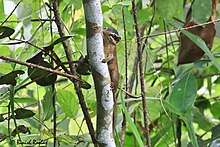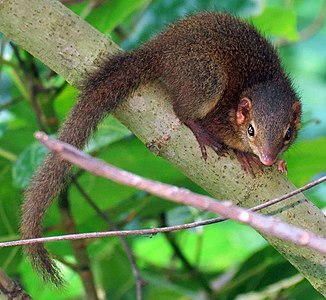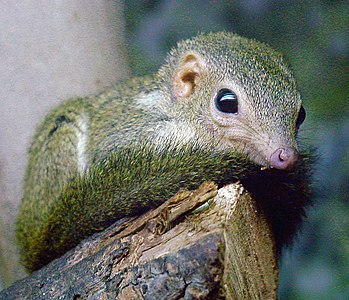Treeshrew
The treeshrews (or tree shrews or banxrings[2]) are small mammals native to the tropical forests of Southeast Asia. They make up the entire order Scandentia, which split into two families: the Tupaiidae (19 species, "ordinary" treeshrews), and the Ptilocercidae (one species, the pen-tailed treeshrew).
| Treeshrews[1] Temporal range: Middle Eocene – Recent | |
|---|---|
| Tupaia sp. | |
| Scientific classification | |
| Kingdom: | Animalia |
| Phylum: | Chordata |
| Class: | Mammalia |
| Grandorder: | Euarchonta |
| Order: | Scandentia Wagner, 1855 |
| Families | |
Though called 'treeshrews', and despite having previously been classified in Insectivora, they are not true shrews, and not all species live in trees. They are omnivores; among other things, treeshrews eat fruit.
Treeshrews have a higher brain to body mass ratio than any other mammal, including humans,[3] but high ratios are not uncommon for animals weighing less than 1 kg (2 lb).
Among orders of mammals, treeshrews are closely related to primates, and have been used as an alternative to primates in experimental studies of myopia, psychosocial stress, and hepatitis.[4]
Name
The name Tupaia is derived from tupai, the Indonesian word for squirrel,[5] and was provided by Sir Stamford Raffles.[6]
Description

_by_Davidraju_img7.jpg)




.jpg)
Treeshrews are slender animals with long tails and soft, greyish to reddish-brown fur. The terrestrial species tend to be larger than the arboreal forms, and to have larger claws, which they use for digging up insect prey. They have poorly developed canine teeth and unspecialised molars, with an overall dental formula of 2.1.3.33.1.3.3[7]
Treeshrews have good vision, which is binocular in the case of the more arboreal species.
Reproduction
Female treeshrews have a gestation period of 45–50 days and give birth to up to three young in nests lined with dry leaves inside tree hollows. The young are born blind and hairless, but are able to leave the nest after about a month. During this period, the mother provides relatively little maternal care, visiting her young only for a few minutes every other day to suckle them.
Treeshrews reach sexual maturity after around four months, and breed for much of the year, with no clear breeding season in most species.[7]
Behavior
Treeshrews live in small family groups, which defend their territory from intruders. Most are diurnal, although the pen-tailed treeshrew is nocturnal.
They mark their territories using various scent glands or urine, depending on the particular species.
Diet
Treeshrews are omnivorous, feeding on insects, small vertebrates, fruit, and seeds. Among other things, treeshrews eat Rafflesia fruit.
The pen-tailed treeshrew in Malaysia is able to consume large amounts of naturally fermented nectar (with up to 3.8% alcohol content) the entire year without it having any effects on behaviour.[8]
Treeshrews have also been observed intentionally eating foods high in capsaicin, a behavior unique among mammals other than humans. A single TRPV1 mutation reduces their pain response to capsaicinoids, which scientists believe is an evolutionary adaptation to be able to consume spicy foods in their natural habitats.[9]
Taxonomy
They make up the entire order Scandentia, split into the families Tupaiidae, the treeshrews, and Ptilocercidae, the pen-tailed treeshrew. The 20 species are placed in five genera.
Treeshrews were moved from the order Insectivora into the order Primates because of certain internal similarities to primates (for example, similarities in the brain anatomy, highlighted by Sir Wilfrid Le Gros Clark), and classified as a "primitive prosimian", however they were soon split from the primates and moved into their own clade. The treeshrews’ relations to primates and other closely related clades are still being refined.
Molecular phylogenetic studies have suggested that the treeshrews should be given the same rank (order) as the primates and, with the primates and the flying lemurs (colugos), belong to the grandorder Euarchonta. According to this classification, the Euarchonta are sister to the Glires (lagomorphs and rodents), and the two groups are combined into the superorder Euarchontoglires.[10] However, the alternative placement of treeshrews as sister to both Glires and Primatomorpha cannot be ruled out.[11] Recent studies place Scandentia as sister of the Glires, invalidating Euarchonta: It is this organization that is shown in the tree diagram below.[12][11]
| Euarchontoglires |
| ||||||||||||||||||||||||||||||
Several other arrangements of these orders have been proposed in the past, and the above tree is only a well-favored proposal.[13] Although it is known that Scandentia is one of the most basal Euarchontoglire clades, the exact phylogenetic position is not yet considered resolved: It may be a sister of Glires, Primatomorpha,[14] or Dermoptera, or separate from and sister to all other Euarchontoglires.[15][16]
Order Scandentia
The 20 species are placed in four genera, which are divided into two families. The majority are in the "ordinary" treeshrew family, Tupaiidae, but one species, the pen-tailed treeshrew, is different enough to warrant placement in its own family, Ptilocercidae; the two families are thought to have separated 60 million years ago.[17] The former Tupaiidae genus Urogale was disbanded in 2011 when the Mindanao treeshrew was moved to Tupaia based on a molecular phylogeny.[17]
- Family Tupaiidae
- Genus Anathana
- Madras treeshrew, A. ellioti
- Genus Dendrogale
- Bornean smooth-tailed treeshrew, D. melanura
- Northern smooth-tailed treeshrew, D. murina
- Genus Tupaia
- Northern treeshrew, T. belangeri
- Golden-bellied treeshrew, T. chrysogaster
- Striped treeshrew, T. dorsalis
- Mindanao treeshrew, T. everetti
- Common treeshrew, T. glis
- Slender treeshrew, T. gracilis
- Horsfield's treeshrew, T. javanica
- Long-footed treeshrew, T. longipes
- Pygmy treeshrew, T. minor
- Calamian treeshrew, T. moellendorffi
- Mountain treeshrew, T. montana
- Nicobar treeshrew, T. nicobarica
- Palawan treeshrew, T. palawanensis
- Painted treeshrew, T. picta
- Ruddy treeshrew, T. splendidula
- Large treeshrew, T. tana
- Family Ptilocercidae
- Genus Ptilocercus
- Pen-tailed treeshrew, P. lowii
Fossil record
The fossil record of treeshrews is poor. The oldest putative treeshrew, Eodendrogale parva, is from the Middle Eocene of Henan, China, but the identity of this animal is uncertain. Other fossils have come from the Miocene of Thailand, Pakistan, India, and Yunnan, China, as well as the Pliocene of India. Most belong to the family Tupaiidae; one fossil species described from the Oligocene of Yunnan is thought to be closer to the pen-tailed treeshrew.[18]
Named fossil species include Prodendrogale yunnanica, Prodendrogale engesseri, and Tupaia storchi from Yunnan, Tupaia miocenica from Thailand, Palaeotupaia sivalicus from India[19] and Ptilocercus kylin from Yunnan.[18]
References
- Helgen, K.M. (2005). "Order Scandentia". In Wilson, D.E.; Reeder, D.M (eds.). Mammal Species of the World: A Taxonomic and Geographic Reference (3rd ed.). Johns Hopkins University Press. pp. 104–109. ISBN 978-0-8018-8221-0. OCLC 62265494.
- Rines, George Edwin, ed. (1920). . Encyclopedia Americana.
- "an article on Tupaia belangeri". The Genome Institute. Washington University. Archived from the original on 1 June 2010.
- Cao, J.; Yang, E.B.; Su, J.-J.; Li, Y.; Chow, P. (2003). "The tree shrews: Adjuncts and alternatives to primates as models for biomedical research" (PDF). Journal of Medical Primatology. 32 (3): 123–130. doi:10.1034/j.1600-0684.2003.00022.x. PMID 12823622. Retrieved January 2012. Check date values in:
|accessdate=(help) - Nowak, R.M. (1999). Walker's Mammals of the World. Baltimore, MD: Johns Hopkins University Press. p. 245. ISBN 978-0-8018-5789-8.
- Craig, John (1849). A new universal etymological technological, and pronouncing dictionary of the English Language.
- Martin, Robert D. (1984). Macdonald, D. (ed.). The Encyclopedia of Mammals. New York, NY: Facts on File. pp. 440–445. ISBN 978-0-87196-871-5.
- Moscowicz, Clara (2008). "Tiny tree shrew can drink you under the table".
- "See Why Tree Shrews Are Only the Second Known Mammal to Seek Spicy Food". nationalgeographic.com. Retrieved 2018-08-26.
- Janecka, Jan E.; Miller, Webb; Pringle, Thomas H.; Wiens, Frank; Zitzmann, Annette; Helgen, Kristofer M.; Springer, Mark S.; Murphy, William J. (2 November 2007). "Molecular and genomic data identify the closest living relatives of the Primates". Science. 318 (5851): 792–794. Bibcode:2007Sci...318..792J. doi:10.1126/science.1147555. PMID 17975064.
- Zhou, Xuming; Sun, Fengming; Xu, Shixia; Yang, Guang; Li, Ming (1 March 2015). "The position of tree shrews in the mammalian tree: Comparing multi-gene analyses with phylogenomic results leaves monophyly of Euarchonta doubtful". Integrative Zoology. 10 (2): 186–198. doi:10.1111/1749-4877.12116. ISSN 1749-4877. PMID 25311886.
- Meredith, Robert W.; Janečka, Jan E.; Gatesy, John; Ryder, Oliver A.; Fisher, Colleen A.; Teeling, Emma C.; Goodbla, Alisha; Eizirik, Eduardo; Simão, Taiz L. L. (28 October 2011). "Impacts of the Cretaceous terrestrial revolution and KPg extinction on mammal diversification". Science. 334 (6055): 521–524. Bibcode:2011Sci...334..521M. doi:10.1126/science.1211028. ISSN 0036-8075. PMID 21940861.
- Pettigrew, J.D.; Jamieson, B.G.; Robson, S.K.; Hall, L.S.; McAnally, K.I.; Cooper, H.M. (1989). "Phylogenetic relations between microbats, megabats, and primates" (PDF). Philosophical Transactions of the Royal Society B. Mammalia: Chiroptera and Primates. 325 (1229): 489–559. Bibcode:1989RSPTB.325..489P. doi:10.1098/rstb.1989.0102. PMID 2575767.
- Lin, J.; Chen, G.; Gu, L.; Shen, Y.; Zheng, M.; Zheng, W.; Hu, X.; Zhang, X.; Qiu, Y.; Liu, X.; Jiang, C. (2014). "Phylogenetic affinity of tree shrews to Glires is attributed to fast evolution rate". Molecular Phylogenetics and Evolution. 71: 193–200. doi:10.1016/j.ympev.2013.12.001.
- Foley, Nicole M.; Springer, Mark S.; Teeling, Emma C. (19 July 2016). "Mammal madness: Is the mammal tree of life not yet resolved?". Philosophical Transactions of the Royal Society B. 371 (1699): 20150140. doi:10.1098/rstb.2015.0140. ISSN 0962-8436. PMC 4920340. PMID 27325836.
- Kumar, Vikas; Hallström, Björn M.; Janke, Axel (1 April 2013). "Coalescent-based genome analyses resolve the early branches of the Euarchontoglires". PLOS ONE. 8 (4): e60019. Bibcode:2013PLoSO...860019K. doi:10.1371/journal.pone.0060019. ISSN 1932-6203. PMC 3613385. PMID 23560065.
- Roberts, T.E.; Lanier, H.C.; Sargis, E.J.; Olson, L.E. (2011). "Molecular phylogeny of treeshrews (Mammalia: Scandentia) and the timescale of diversification in Southeast Asia". Molecular Phylogenetics and Evolution. 60 (3): 358–372. doi:10.1016/j.ympev.2011.04.021.
- Li, Q.; Ni, X. (2016). "An early Oligocene fossil demonstrates treeshrews are slowly evolving "living fossils"". Scientific Reports. 6 (1). doi:10.1038/srep18627.
- Ni, X.; Qiu, Z. (2012). "Tupaiine tree shrews (Scandentia, Mammalia) from the Yuanmou Lufengpithecus locality of Yunnan, China". Swiss Journal of Palaeontology. 131: 51–60. doi:10.1007/s13358-011-0029-0.